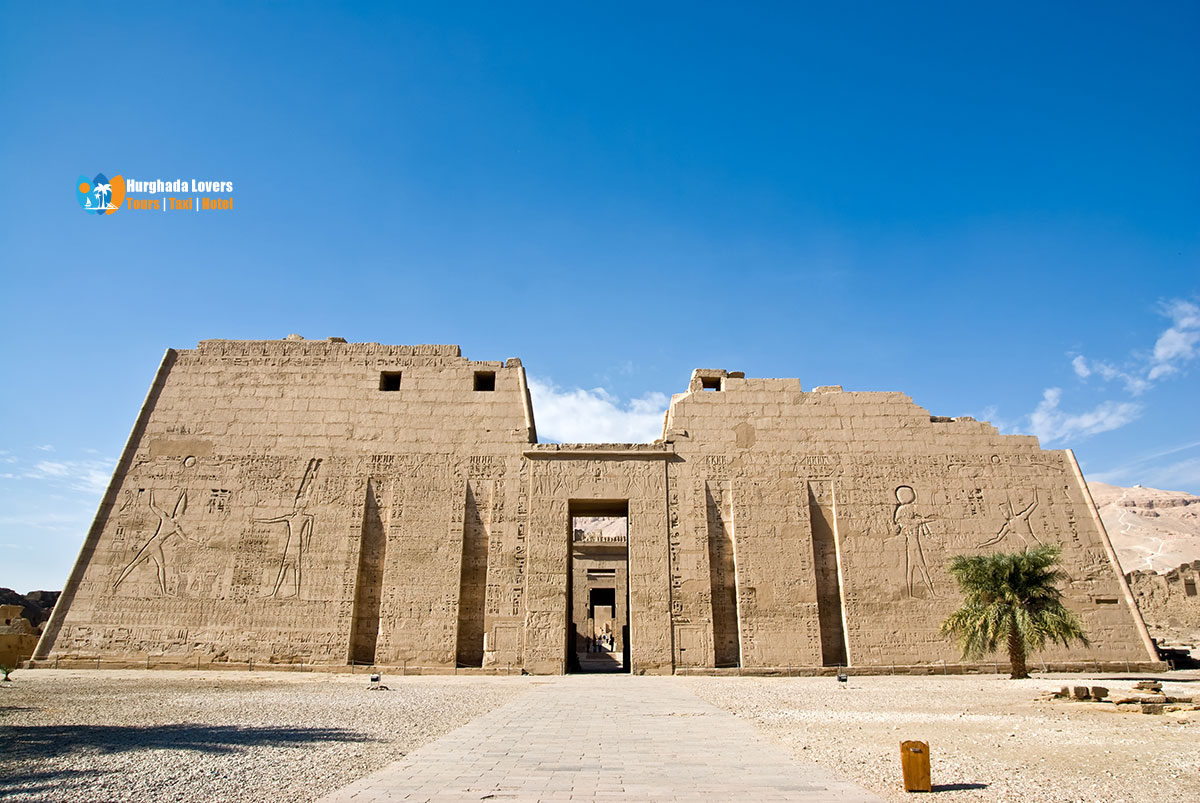Pharaonic Temple of Medinet Habu – The History Of Egyptian of the construction of the funerary complex of Medinet Habu of King Ramses III in Luxor, Ancient Egypt.
the facts and secrets of the construction of the largest Pharaonic Temples fortified by the ancient Egyptian civilization and what is the plan inside the temple and the prices of entrance tickets and visit dates and a complete map of the ancient city of Habu to start your sightseeing trip & Things to Do in Egypt.
Hurghada lovers Offer Luxury Hurghada to Luxor Tours | El Gouna to Luxor Tours | Makadi bay to Luxor Tours | Sahl Hasheesh to Luxor Tours | Soma bay to Luxor Tours.
Facts about the temple of Medinet Habu:
- It is considered one of the largest fortified Pharaonic funerary temples in the New Kingdom of the Pharaonic civilization.
- Temple area = 320 * 220 meters.
- The height of the outer wall of the temple = 18 meters.
- The temple contains 5 large statues of King Ramses III and his wives, in addition to 16 ruined statues, of which only the bases of the statues remain.
Who built the temple of Medinet Habu?
King Ramses III “Egyptian Pharaohs kings“.
The royal architect: Hapo son of King Thutmose III.
Construction Supervisor: Amon Mess. General Supervisor of the Treasury of the Temple of Amon in Thebes.
Why is Habu Temple built?
- The temple was dedicated to the God Amun, Sekhmet the Goddess of War, and the God Osiris the god of the afterlife.
- Recording of the wars and victories of King Ramses III on the walls of the temple.
Why is the Temple of Ramses III named the Temple of Medinet Habu?
- The reason for this name is due to the funerary complex of Habu, built by King Ramses III in Thebes.
- In Coptic times, the second court was transformed by the Copts into a church to practice their worship in the temple of Ramses III and there was a famous Coptic monk named Habo or Hapo.
- There are explanations from archaeologists that the reason for the designation is due to the minister Amenhotep son of Hapo during the reign of King Amenophis III.
What is the importance of the temple of Medinet Habou?
The ancient Egyptians had a solid belief that the city of Habu and in particular the area of the temple of Medinet Habu,was the holy area where the goddess of creation was located, according to the cosmogony of El-Ashmoneen in ancient times.
When was the temple of Medinet Habu built?
The temple was built at the time of the 20th Pharaonic dynasty.
The age of the temple: 3200 years.
Design of the temple of Medinet Habou from the inside:
Main entrance:
The architectural design of the temple consists of an outer wall, an inner wall, and a river port, then a large gate formed two Syrian fortress style towers to build the entrances to the royal castle, where there are balconies and, in the middle, there is the large entrance to the site.
The Hypostyle Hall:
In the large Hypostyle Hall of the temple there are 3 entrances, the first leads to the main chapel of the temple or the holy of holies dedicated to Amon while the second entrance leads to the chapel of the God Khonsu and the third entrance leads you to that of the Goddess Mut.
What is the Holy Triad of Thebes?
It is a sacred area in the temple of Medinet Habu called the Holy of Holies surrounded by a group of rooms, especially for the worship of Egyptian gods, and chambers that served as a deposit of ritual utensils.
The Holy of Holies area was built to serve King Ramses III during his sacred journey to eternity.
The City of Habu:
- The funerary city of Habu is located south of the Theban Necropolis on the west bank of the Nile.
- The area of Medinet Habu = 400 * 200 square meters, or 10 acres.
- The architectural design of the city of Habu in the style of ancient fortified Syrian cities where when King Ramses III saw it during his wars he was impressed by Syrian architectural designs, he built the city in the same style.
- The city contains a group of ancient Pharaonic monuments such as the Holy of Holies, the hypostyle halls the palace of millions of years.
Inscriptions of the temple of Medinet Habu:
You will see an inscription on the walls of the main gate of the scenes of King Ramses III while waging wars and military campaigns against the enemies of ancient Egypt.
About the King Ramses III:
Reigne: 1186 – 1155 BC J.-C.
Pharaonic Dynasty: The 20th Dynasty
Sons:
- King Ramses IV
- Ramses VI
- Ramses VIII
- Amon Her Khepeche-ef
- Mery Amon.
Father: King Seth Nacht
Mother: Queen Tiy Meren-es
Date of death: 1155B.C.
Burial place: Ramses III tomb No. 11 in the Valley of the Kings in Luxor.
The address of the Temple of Medinet Habu:
The West Bank, Luxor, Egypt.
Dates of visit of the Temple of Medinet Habu:
Sunday 6h00-17h00
Monday 6h00-17h00
Tuesday 6h00-17h00
Wednesday 6h00-17h00
Thursday 6h00-17h00
Friday 6h00-17h00
Saturday 6h00-17h00
Tickets prices for the Temple of Medinet Habu:
The ticket price of a foreign tourist = 100 Egyptian pounds.
The ticket price of a foreign student = 50 Egyptian pounds.
The price of an Egyptian ticket = 10 Egyptian pounds.
The price of an Egyptian student’s ticket = 5 Egyptian pounds.
Author & Writer: Tamer Ahmed Abd elfatah Yousif
Medinet Habu Luxor | Facts largest Pharaonic funerary Temple Egypt


